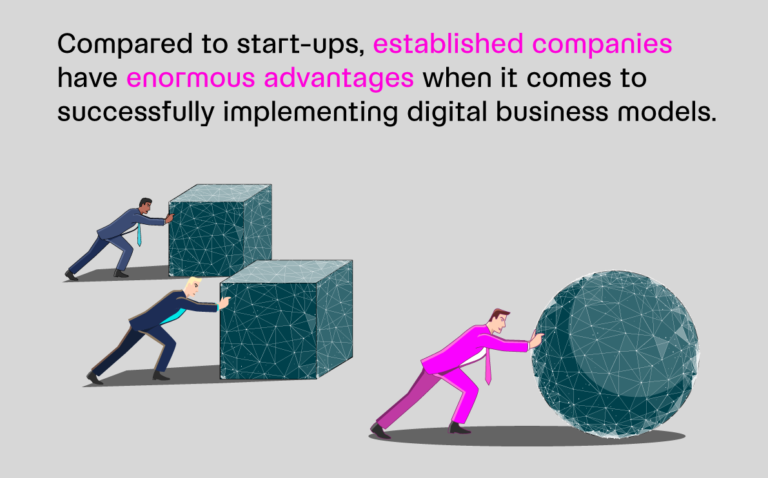Small and medium-sized enterprises have been confronted with new challenges in recent years. Start-ups are pushing into the market, and not only in the technology sector. Compared to a classical SME, start-ups have enormous growth rates and an agile structure. This allows them to introduce products to the market quickly and take more and more market share away from their traditional competitors. Digital structures and business models are the strength of start-ups. SMEs cannot ignore this development if they want to survive in the market. They also need to introduce digital business models themselves and integrate them into their business structure.
Nevertheless, many companies find the project ” digitalisation in medium-sized businesses” difficult. Therefore, in this article we will demonstrate what makes the approach of start-ups so promising and how small and medium-sized companies themselves can make the leap to digitalisation.
How digital transformation challenges traditional businesses
Digital transformation is the buzzword of recent years. It is not always clear what is meant when people talk about digital transformation. Is the change from letter to e-mail for the annual Christmas greeting to customers already a digital transformation?
Digital transformation takes place where existing structures are digitalised, or new digital structures are created. This also includes the change from letter to e-mail, but it is to be understood much more comprehensively:
- Digital, automated sales and marketing structures
- New types of customer loyalty, support and service
- New products, services and business models
But technical innovation is only one of the challenges facing small and medium-sized enterprises.
The second challenge comes from those market players for whom digitalisation is already ingrained in their DNA: start-ups. From the very beginning, they have relied on digital business models and their structure is also digital and agile. The rapid growth of start-ups is fed by this momentum.
At the same time, there is a fundamentally different error culture in start-ups. In classic corporate structures, internal demands are often characterised by a zero-tolerance policy towards mistakes. However, it is difficult to prohibit mistakes. In the context of digital transformation, such a corporate culture also proves to be a brake on innovation. Trying out new things means making mistakes. Start-ups have realised this and found a productive way of dealing with it.
Additionally, digital change also requires qualified personnel who are capable of shaping said change. However, it is often difficult for SMEs to attract the top talents from IT, because large corporations offer better conditions, and young start-ups offer a corporate culture that is more in line with the needs of IT talents.
To summarise, there are four challenges for traditionally positioned companies with an analogue business model:
- Digital transformation provides tools, environments and opportunities to improve existing business processes and implement new business ideas
- Start-ups have realised and perfected this. They are able to quickly design new products, launch them on the market and adapt them to the customer.
- A zero-error policy prevents small and medium-sized enterprises from innovating
- It is difficult for small and medium-sized companies to retain qualified IT personnel, because they can neither pay as well as large corporations, nor offer the same structures as young start-ups
But these challenges can also be an opportunity: Companies that make the leap into the digital age set themselves apart from the competition and strengthen their market position in the long term.
Digital business models in medium-sized companies
Digital business models are models, whose value is partly or entirely derived from the use of digital technologies. Examples of such business models are Ebay, Hubspot or Netflix. But not only complete digital companies benefit from the digital transformation. Traditional companies can also use digital technologies to set themselves apart from the competition.
Examples of digital business models in medium-sized companies:
- A furniture manufacturer develops a configurator with which customers can configure and order an individual piece of furniture.
- A lawyer offers online advice to clients.
- A moving company develops an app for the collection of moving goods so that the customer can book the move online.
Using digitalisation to optimise existing business processes
Technology has developed rapidly in recent years and not only in the user sector. Today, a large number of tools are available to companies, with which a business infrastructure can be digitalised to the greatest possible extent. Starting with Cloud-ERP over digital distribution systems up to completely digital companies.
Frameworks are also available in management with which agile structures can be implemented; project management methods such as Scrum are not only fruitful in software development, but wherever a product is developed.
On a structural level, digitalisation means important efficiency gains, which small and medium-sized enterprises must also take away if they want to defend their market position.
Examples for the digitalisation of processes in companies:
- A research institute uses Scrum in the development of a book. The book is treated like a feature
- In the past, a plant manufacturer had to regularly send field staff to the customer to perform routine tasks. By implementing a digital monitoring system that is directly connected, he can reduce this number by half.
- The sales in a construction machinery rental company have so far been mainly by telephone. After the implementation of a landing page and an e-mail marketing system, the company can streamline existing structures and expand the sales channels.
MVP development: Failure as a principle of success
It may sound strange, but one of the main strengths of start-ups is failure. More precisely, methodical, structured failure.
The Fail-Fast Principle is about making mistakes quickly and learning from them, instead of forever developing a product in the background without seeing the market.
The strengths of start-ups are not only better technology and a digital business model from the outset. They are based on a fundamentally different philosophy known as the lean start-up method. A central building block is the MVP: the Minimum Viable Product.
The basic idea of the MVP: There is no such thing as a perfect product, because the market, customer requirements and technology are constantly changing. Therefore, a product should be brought to market as quickly as possible, which is then tested and further developed.
Failure in the short term, success in the long term
The first version of an MVP contains only the most important functions. These are the features without which a customer has no reason to buy the product. Why should future customers spend money on the product? What are the must-haves of the product? An MVP consists only of such must-haves.
Once this product is developed, customer feedback is systematically evaluated and included in the next iteration of the product.
With an MVP, a company is able to go to market in a short time, generate attention and feedback from customers and incorporate this feedback into further iterations. If there is no demand, this also becomes visible. With each iteration, the product fits better to the customers’ requirements. This iteration process knows no end. This reduces the overall risk of total failure.
If you want to learn more about how to develop an MVP check our article about Overcoming the challenges of building an MVP.
Lower investment costs with MVP development
This also has an impact on costs. Every company has recurring costs for personnel, rent and infrastructure, regardless of whether a product is on the market. A lot of time passes before the real product comes into contact with customers and high investment costs are necessary. With an MVP the investment costs decrease. Instead of spending a lot of money on market research and prototypes, an MVP is brought to market as quickly as possible. As a result, an MVP only has to pay about 10% of the development costs for a complete product on average.
Opportunity costs are also high. This is because an MVP already makes money when the classic product is still in development. The overall losses are thus smaller and are recovered earlier.
Conclusion: Develop and test your own digital business models quickly with an MVP
In the medium and long term, all companies must face the challenges of digital transformation. Those who have not integrated digital business models into their companies in the next 10 years, will find it difficult to keep up with agile, rapidly growing start-ups.
This process need not be complicated, because taking digitisation seriously also means moving away from traditional product development cycles. With an MVP, SMEs also have the opportunity to quickly implement new ideas for digital business models and test them on the market.
Many SMEs lack the human resources to develop an MVP in-house. Therefore, it is often sensible to outsource the development of the MVP to a service provider. This is still cheaper than traditional product development.
Those who set the relevant processes in motion at an early stage have the chance to secure an important lead over their competitors.




